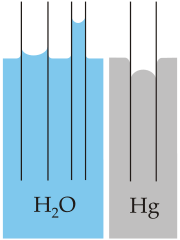Capillary action
Capillary action, or capillarity, refers to certain phenomena associated with the behavior of liquids in thin tubes or in porous materials. Liquids, such as water, will tend to move "up-hill" (against the force of gravity) which does not normally occur in large containers. The interface between liquids, or a liquid and a gas, can form a meniscus or crescent shape.
Contents |
Etymology
The word "capillary," in the non-medical sense, means narrow tube. The word comes from Latin capillaris ("pertaining to the hair") < capillus ("the hair, prop. of the head") < caput ("head").[1] In medicine and biology, it usually refers to the smallest blood vessels.
Phenomena and Physics of Capillary Action

Capillary action, capillarity, capillary motion, or wicking refers to two phenomena:
- The movement of liquids in thin tubes.
- The flow of liquids through porous media, such as the flow of water through soil.
A common apparatus used to demonstrate the first phenomenon is the capillary tube. When the lower end of a vertical glass tube is placed in a liquid such as water, a concave meniscus forms. Surface tension pulls the liquid column up until there is a sufficient mass of liquid for gravitational forces to overcome the intermolecular forces. The contact length (around the edge) between the top of the liquid column and the tube is proportional to the diameter of the tube, while the weight of the liquid column is proportional to the square of the tube's diameter, so a narrow tube will draw a liquid column higher than a wide tube.
In hydrology, capillary action describes the attraction of water molecules to soil particles. Capillary action is responsible for moving groundwater from wet areas of the soil to dry areas. Differences in soil potential ( ) drive capillary action in soil.
) drive capillary action in soil.
Examples
Capillary action is also essential for the drainage of constantly produced tear fluid from the eye. Two canaliculi of tiny diameter are present in the inner corner of the eyelid, also called the lacrymal ducts; their openings can be seen with the naked eye within the lacrymal sacs when the eyelids are everted.
Wicking is to absorb something and then drain like a wick. Paper towels absorb liquid through capillary action, allowing a fluid to be transferred from a surface to the towel. The small pores of a sponge act as small capillaries, causing it to absorb a comparatively large amount of fluid. Some modern sport and exercise fabrics use capillary action to "wick" sweat away from the skin. These are often referred to as wicking fabrics, after the capillary properties of a candle and lamp wicks.
Capillary action is observed in thin layer chromatography, in which a solvent moves vertically up a plate via capillary action. Dissolved solutes travel with the solvent at various speeds depending on their affinity for the solvent (the mobile phase) or the absorbent coating on the plate (the stationary phase).
With some pairs of materials, such as mercury and glass, the intermolecular forces within the liquid exceed those between the solid and the liquid, so a convex meniscus forms and capillary action works in reverse.
Formula
_(bjl).svg.png)
The height h of a liquid column is given by:[2]
where:
-
 is the liquid-air surface tension (energy/area)
is the liquid-air surface tension (energy/area)- θ is the contact angle
- ρ is the density of liquid (mass/volume)
- g is acceleration due to gravity (length/time2)
- r is radius of tube (length).
For a water-filled glass tube in air at sea level, using SI units:
therefore, the height of the water column is given by:
 .
.
Thus for a 2 m (6.6 ft) diameter tube, the water would rise an unnoticeable 0.014 mm (0.00055 in). However, for a 2 cm (0.79 in) diameter tube, the water would rise 1.4 mm (0.055 in), and for a 0.2 mm (0.0079 in) diameter tube, the water would rise 140 mm (5.5 in).
Miscellaneous
Albert Einstein's first paper[3] submitted in 1900 to Annalen der Physik was on capillarity. It was titled Folgerungen aus den Capillaritätserscheinungen, which translates as Conclusions from the capillarity phenomena, found in volume 4, page 513 (published in 1901).
See also
- Capillary fringe
- Capillary wave
- Frost flowers
- Frost heaving
- Needle ice
- Washburn's equation
- Wick effect
- Bound water
References
- ↑ http://en.wiktionary.org/wiki/capillary
- ↑ G.K. Batchelor, 'An Introduction To Fluid Dynamics', Cambridge University Press (1967) ISBN 0521663962
- ↑ List of Scientific Publications of Albert Einstein

